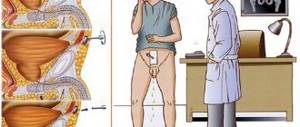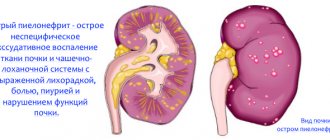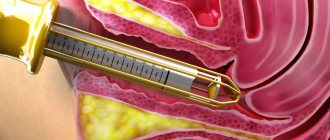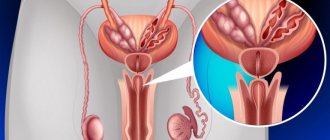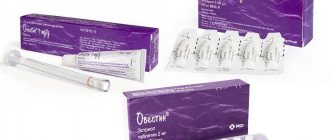The birth of a child is a long-awaited and exciting moment in the life of every woman. But this event is overshadowed by a number of consequences that arise as a result of bearing a child. One of these ailments is urinary incontinence after childbirth. This is a condition in which a woman experiences uncontrollable urine output. Therefore, many women faced with this problem are interested in the question: why does urinary incontinence occur after childbirth and how to deal with this disease?
Related articles:
Kegel exercises for urinary incontinence - rules of implementation Urinary incontinence when coughing - causes and treatment We treat urinary incontinence in women in simple ways Treatment of urinary incontinence with tablets Treatment of urinary incontinence in children
Urinary incontinence: concept
This disease is characterized by spontaneous release of urine. Currently, the pathology is not uncommon; most often it is detected in the postpartum period and in women over 40 years of age.
The disease does not pose a serious threat to health, but it significantly reduces the quality of life and negatively affects the psycho-emotional state. Many women believe that urinary incontinence after childbirth is a normal condition. Contrary to popular belief, it must be treated.
conclusions
Medical science does not stand still, but is developing by leaps and bounds. New developments in the treatment of pathology are being introduced. Pharmaceutical companies are doing significant work to help solve the problem of urinary incontinence after childbirth. Pharmaceutical scientists are working to produce drugs that can have a targeted effect on the source of the disease.
Urinary incontinence after childbirth is a treatable process. Women planning a pregnancy and those already expecting a baby are strongly advised to monitor their health. Do not ignore the process of urination. In order to cope well with the responsibilities of a mother, you should not neglect the disease. You cannot leave a visit to the doctor “for later”, citing being busy with the baby. The child needs an active, healthy mother. Be attentive to your physical condition. If you are diagnosed with urinary incontinence, follow your doctor's recommendations.
Date: 05/13/2016
Symptoms
It is important to understand that isolated cases of urinary incontinence in women after childbirth do not always indicate pathology. One-time episodes can also occur in a completely healthy person.
The following symptoms serve as the basis for diagnosis:
- Involuntary urine discharge occurs regularly, including at night. It cannot be controlled.
- The volume of urine leaked is usually significant.
- Episodes of incontinence occur during sports, sexual intercourse, and being under stress.
- After emptying the bladder, residual secretions continue to flow out.
- Frequent and sudden urges.
However, even if the involuntary discharge of urine is not regular, it is necessary to consult a doctor in order to confirm or rule out the presence of an inflammatory process in the body.
A little about the anatomy of the pelvic floor muscles
The pelvic floor is a kind of layer, which consists of three muscle layers. There are two types of pelvic floor. The anterior perineum (front of the pelvic floor) is located between the anal sphincter and the back of the labia, and the posterior perineum is between the tailbone and the anus. The main role of the perineal muscles is to support the organs located in the pelvic cavity (including the bladder and urethra), control the act of defecation, and the birth of the fetus. The circular muscles of the pelvis tightly cover the final section of the large intestine and the urethra, thus forming sphincters.
Organs that support the pelvic muscles
Types of incontinence
There are several types of the disease, each of which has characteristic symptoms.
Urinary incontinence is of the following types:
- Urgentnoe. It is impossible to control, the urge to urinate is very strong and appears suddenly.
- Stressful. Urine leakage is observed even with slight exertion. For example, urinary incontinence appears after childbirth when sneezing, laughing, coughing, during physical activity of both low and high intensity, etc.
- Paradoxical ischuria. Spontaneous release of urine occurs when the bladder is full. In this case, it is impossible to control the process.
- Reflex. The act of involuntary urination is a consequence of fear. It can also occur if a person hears the sound of flowing water.
As a rule, in women after childbirth, urinary incontinence is of a stress nature.
How to treat?
If infectious, neurological and other causes are excluded, the urologist prescribes a non-invasive treatment method. It consists of performing exercises to restore the muscles of the perineum. This technique bears the name of its author, Kegel. The effect of such a treatment is assessed after a year.
The essence of these exercises is to alternately tense and relax the pelvic muscles at different speeds. This brings them into good shape. The Kegel technique must be practiced for many months every day, only then can you achieve success. To feel the muscles of the perineum, it is enough to hold the stream of urine while urinating.
Also an excellent exercise is pushing out, in which you need to strain the muscular corset of the perineum as during labor. Many women note an improvement in their condition after 3-4 months of regularly performing the Kegel method. The more often the exercises are performed, the faster the disease will pass.
Electrical muscle stimulation is a great addition to Kegel exercises. And also electromagnetic therapy.
In case of weak dynamics, surgical treatment is possible, during which a special support is created for the urethra, thus fixing it. The main types of surgical intervention include:
- the use of a special gel that is injected into the urethra;
- fixation of the urethra, cervix and bladder in different ways (urethrocystopexy);
- fixation of only the middle part of the urethra using a polypropylene loop (synthetic material).
Most often, minimally invasive loop operations are performed, which have the least complications and short recovery period.
As for drug correction, only sedatives (calming) can be noted here. There are no medications to relieve urinary incontinence.
Yoga trains all muscle groups, including the perineal muscle corset
Among the general methods, the doctor usually recommends the following measures:
- avoid constipation;
- lose weight;
- drink enough water;
- do not consume spicy and salty foods, as well as alcohol;
- Empty your bladder in a timely manner.
Causes
The occurrence of complications is associated with changes occurring in a woman’s body during pregnancy and its completion.
The following are considered the main causes of urinary incontinence after childbirth:
- Weak ligaments. During pregnancy, changes occur in the pubic and iliosacral joints. They are characterized by gradual relaxation of the ligaments, which is normal during pregnancy.
- Weak pelvic muscles. The closer the birth process is, the higher the concentration of the hormone relaxin in the blood. This substance is necessary in order to weaken the muscles and ligaments of the pelvic floor. This is necessary to increase the degree of bone dynamics.
- Expansion of pelvic tissues. The separation of the bones during labor is necessary to prevent the child from being injured.
- Breaks. They are not uncommon during childbirth. In addition, doctors may resort to episiotomy, a method of facilitating the passage of the child, which involves cutting the perineum. A natural consequence of ruptures and this surgical procedure is urinary incontinence after childbirth when coughing, playing sports, sneezing, etc.
The following factors also influence the increased likelihood of complications:
- hereditary predisposition;
- excess body weight;
- developmental anomalies of the pelvic organs;
- psychoemotional disorders;
- hormonal disbalance;
- pathologies of the nervous system;
- the person has been exposed to radiation in the past;
- Previously, surgical intervention was performed in the pelvic organs.
Thus, there are many reasons for urinary incontinence in women after childbirth, and therefore a thorough examination is recommended for each patient.
It hurts to write after childbirth - What to do?
Non-infectious:
- injuries sustained as a result of a child passing through the canals;
- pathologies of the genitourinary system that arose earlier;
- psychological and emotional stress (in the case of difficult conditions for the birth of a child);
- mechanical damage - occurs when using a catheter or other medical instruments.
It should be noted that pain syndrome of the urinary system is possible both during natural childbirth and during cesarean section. In the second case, unwanted discomfort is caused by sutures. If a woman notices one or more of the above reasons in her health, then there is no need to worry about her health; problems with urination will disappear within a couple of days, and will finally disappear a month after giving birth.
Infectious:
- Inflammation of the urethra after childbirth is caused by the development of infection on the mucous membranes. This is possible due to insufficient sterility. Causes burning and stinging when going to the toilet.
- Cystitis is an infectious disease that occurs due to inflammation of the inner lining. Accompanied by a burning sensation of the external genital organs and nagging pain in the lower abdomen.
- Endometritis is a pathology that occurs in women in labor and is accompanied by an inflammatory process of the mucous membranes of the uterus. Causes an increase in temperature and brown discharge with a strong unpleasant odor.
Infectious inflammations can also be caused by:
- remnants of the placental membrane in the uterus,
- avitaminosis,
- lack of hygiene,
- bleeding disorder,
- profuse blood loss,
- surgical interventions,
- weak contractile activity of the uterus.
If painful urination does not go away for more than 7 days and is accompanied by symptoms such as burning in the vagina, fever, discharge with a strong odor, then this indicates the development of an infectious disease of the genitourinary system.
› Health › Is it painful to write the first surprise after childbirth and is it possible to avoid it
Recovery after childbirth requires a sufficient amount of time and patience from the new mother. The natural needs that a woman faces every day can cause a lot of discomfort and darken the first days of motherhood. Immediately after giving birth, most mothers are faced with an annoying nuisance - it hurts to pee.
Doctors assure that painful urination after childbirth is an understandable and completely normal phenomenon, which is the result of injuries and damage received during the birth of a child. But this sounds of little comfort to young mothers, who worry that the pain that arises may be a manifestation of some complications. Let's figure it out.
Problems
Most women experience problems with urination after childbirth. Painful sensations can be caused by injuries, abrasions, perineal tears and sutures.
Pain syndrome also appears due to injury to the walls of the bladder and urine outflow channels. Often, such painful sensations disappear in the first 2-3 days.
Burning when urinating also causes discomfort, which prevents you from quickly returning to a full life and enjoying the happiness of motherhood.
Therefore, when you want to relieve yourself, the impulse does not reach the brain, and accordingly, the command to empty the overfilled organ does not work.
And this threatens to overfill the bladder, increasing its size, which does not allow the uterus to contract.
Frequent urges can also bother a woman in labor for the first few days. This is due to the fact that the body is trying to remove excess fluid. If you want to go to the toilet often, but the amount of urine is very small, consult a doctor, as this indicates the beginning of an inflammatory process.
Read also: Very scanty periods after childbirth while breastfeeding
Incontinence - occurs as a result of dysfunction of the pelvic organs and pelvic floor, which experience excessive stress during pregnancy and childbirth. In this case, the outflow occurs involuntarily with slight physical exertion (coughing, sneezing), the influence of external factors, and also with the urge to go to the toilet.
Prevention
The risk of occurrence can be minimized. To do this, just follow the following recommendations:
- Maintain hygiene of the genitals and urethra. A mandatory condition, as it prevents the occurrence and penetration of infection into the urinary system. Wash yourself at least 4 times throughout the day. And it is better to do this with the help of special gels and foams approved for use during this period.
- In the first days after the birth of a child, you should never use tampons; they can cause infectious inflammation. It is better to give preference to pads with a “breathable” base.
- Despite the pain when urinating, you should visit the toilet every 2 hours. This helps relieve bladder tension.
- Drink plenty of fluids. Fruit drinks or compotes that have anti-inflammatory properties due to their composition are especially suitable.
- Move more. Walking is good. But don’t overdo it with physical activity, don’t lift weights, and after a walk with your baby, it’s better to devote a couple of hours to rest.
- Additionally, you can do Kegel exercises, which will strengthen the pelvic muscles and reduce inflammation. This exercise is performed 5 times a day. For tears and cuts, it should be done only after healing.
- During the first days, lie down on your stomach more often. This has a beneficial effect on the removal of all excess from the uterus, which can cause inflammation.
Read also Lochiometra after childbirth: what is it, symptoms
These recommendations will help eliminate painful urination after childbirth as soon as possible. However, if a woman is faced with an infectious inflammation, then only the help of a highly qualified specialist and a course of medications can help get rid of the disease.
If, nevertheless, you are faced with a problem with urination after childbirth, then there is nothing else to do but try to reduce the discomfort.
This can be done through the following steps:
- apply a cold compress for 20-30 seconds after going to the toilet to reduce pain;
- take a warm shower to relax;
- for cystitis, a warm heating pad placed in the lower abdomen at night helps well; this method will help relax and reduce pain;
- drink decoctions of chamomile and lingonberry leaves - reduces inflammation and has an analgesic effect;
- follow a diet - avoid eating fatty, salty, spicy, and carbonated drinks;
- increase the amount of first courses in your diet;
- for inflammatory processes, you can use a foot bath with well-heated water. Upon completion of the procedure, do not forget to wear warm socks.
- When going to the toilet, use a standing position over the bidet to reduce the effect on existing seams and damage.
Remember that you should not self-medicate if you see obvious reasons to see a doctor! After all, any manifestations of maternal health problems can harm the baby.
Thus, to restore normal functioning of the genitourinary system, a certain period must pass. Pain when visiting the toilet “little by little” causes a lot of difficulties and inconvenience for a young mother.
When identifying the symptoms of this disease, it is very important to immediately begin to eliminate it: consult a doctor, undergo an examination and a course of medications. However, we must remember about the prevention of this disease; if symptoms have not yet appeared, then it is possible to minimize the risk of their occurrence.
Diagnostics
During a conversation with the patient, the doctor needs to establish the type of pathology and determine the degree of its manifestation.
During the history taking process, he should receive answers to the following questions:
- how many births the woman had, whether complications arose;
- does she have any chronic diseases;
- whether a hormonal imbalance has ever been detected;
- whether surgery was performed;
- whether the patient suffers from pathologies of the nervous system.
In addition, the doctor may ask other questions that may not seem entirely appropriate to the woman, since they relate to her personal life. It is necessary to understand that this information is required by a specialist in order to make an accurate diagnosis, so it is important to provide it.
Diagnosis of urinary incontinence consists of several stages:
- Examination on a gynecological chair. The doctor evaluates the location of the organs of the reproductive system, checks the presence or absence of neoplasms, examines the mobility of the bladder neck, examines the mucous membrane and skin in the perineal area. After this, he takes biomaterial for research from the urethra, cervix and vagina. These tests are necessary to confirm or exclude the presence of inflammatory processes. A general urine test and bacterial culture are also mandatory.
- Keeping an observation diary. In order to obtain the most complete information about the existing pathology, the doctor recommends that the patient write down the following information for 2-3 days: how much liquid was drunk during the day, how much urine was excreted at one time, how many acts of urination and episodes of incontinence there were in 24 hours ., how many pads were used, what load the patient was exposed to. Analysis of the observation diary will help the urologist not only in making a diagnosis, but also in drawing up an effective treatment regimen.
- Instrumental research. As a rule, the patient is prescribed a transvaginal ultrasound, during which the condition of the urethra, the bladder itself is analyzed, and sphincteric insufficiency is detected or excluded.
After completing all diagnostic measures, the doctor makes a diagnosis and prescribes treatment. In cases where it is ineffective, the results obtained do not correspond to the symptoms, the woman suffers from psycho-emotional disorders, etc., a comprehensive urodynamic examination is indicated. It includes: uroflowmetry, cystometry, cystoscopy.
If, during the diagnostic process, a woman’s nervous system disorders are identified, she is referred for a consultation with a psychotherapist or neurologist. A consultation with an endocrinologist is often necessary.
Diagnosis by cough
To make a diagnosis, a consultation with a gynecologist and urologist and an examination in a gynecological chair are necessary. During it, the doctor may ask the patient to cough - this is the so-called “cough test”. If a small amount of urine is released, it is considered positive. During the examination, smears are also taken from the vagina and cervix for microscopic examination. To exclude other pathologies in which urine retention is also poor (for example, cystitis), the doctor may additionally prescribe an ultrasound of the kidneys and bladder.
Conservative treatment
Urinary incontinence after childbirth in women is a pathology, for the treatment of which medications are prescribed extremely rarely. The exception is when the patient is diagnosed with enuresis. To reduce the severity of symptoms, it is recommended to take vitamins and medications that have a positive effect on the condition of blood vessels, the circulatory process and the functioning of the nervous system.
The main conservative methods of treating urinary incontinence after childbirth:
- Strengthening the muscles of the organ itself and the pelvic floor. Your doctor may recommend exercises using weights and vaginal cones. Holding foreign objects helps to gradually strengthen the muscles of the vagina and those involved in the process of urination. A good effect is achieved by regularly performing Kegel exercises. They are also based on muscle training. To understand which of them and how you need to strain, you need to stop the stream during urination and remember these sensations. Thus, you need to constantly strain the muscles of the rectum and vagina. To achieve the best results, you must perform at least 200 repetitions per day.
- Carrying out urination according to schedule. Its essence lies in the fact that the patient must empty the bladder at a strictly prescribed time by the doctor. This method helps improve bladder function and gain control over the situation. For each woman, the schedule is developed individually. It must be followed for at least 2 months.
- Physiotherapy. As a rule, treatment with electromagnetic waves is prescribed. In combination with exercises, this method brings the best results.
At the end of the course of treatment, the doctor evaluates the changes. If they are insignificant or absent altogether, surgical intervention is prescribed.
Surgery
Surgical treatment for incontinence is not used very often. Such operations are performed only as a last resort, when it is impossible to get rid of incontinence by other means. Urine leakage resolves after childbirth as a result of the following interventions.
Correction using gel. During this manipulation, the doctor injects the patient with a special substance. Thanks to its action, additional support is formed around the urethra, which prevents sudden movements of the urethra. The duration of this operation is no more than 20-30 minutes, it is performed under local anesthesia.
Loop interference
When carrying out such a treatment procedure, a special device is placed in the middle of the urethral tract. It has the shape of a loop (hence the name) and also performs a supporting function. The operation takes place quite quickly, the entire installation process takes 30-40 minutes. The woman is discharged already on the 2nd day, and after 1.5-2 months she is allowed to have sexual contact with the opposite sex. The method is effective even in the most difficult situations. Contraindications in this case include another pregnancy.
Urethrocystocervicopexy
The most popular method of surgical correction. It is used when urine does not remain in patients after cesarean section or childbirth. This intervention strengthens the pelvic ligaments. The manipulation itself is technically more complex than the two previous therapy methods. After its completion, the patient’s body requires a long recovery.
For many representatives of the fairer sex, the normal functioning of the urethra and bladder is restored over time. In some cases, as a result of prolonged mental stress and severe stress that arose during childbirth, an incorrect reflex can become entrenched in a woman’s body for a long time. It is this that causes uncontrolled urination or leakage of urine.
Remember that urinary incontinence may not go away on its own. If such a deviation appears after childbirth, it is necessary to find out the cause of the pathology and eliminate it in a timely manner. By delaying treatment for a long time, you worsen your condition and complicate the doctor’s work in the future, because in the early stages these disorders are very easy to treat.
Surgery
In practice, several methods of getting rid of pathology are used. Typically, the operation takes 30 to 45 minutes. It is performed under local anesthesia. On the second day, the woman is discharged from the hospital, but if her daily activities are associated with intense physical activity, the patient can begin this no earlier than 2 weeks after the operation.
Possible complications include: damage to the walls of the bladder, blood vessels, and intestines. Contacting a highly qualified doctor reduces the likelihood of these risks to a minimum.
Preventive measures
In order to prevent the occurrence of complications, it is necessary to follow simple recommendations throughout your life:
- regularly train the muscles of the pelvic floor and vagina;
- do not tolerate if the bladder is full;
- eat a balanced diet, do not abuse alcoholic beverages, do not smoke;
- keep body weight under control;
- empty your bowels regularly;
- observe the drinking regime.
Paying attention to your health significantly reduces the risk of pathology.
Preventing urinary problems before birth
This primarily applies to those who have a history of urinary incontinence in their family. But it will be useful for others to remember a few simple rules.
- Watch your weight. A fit, slender figure is not only beautiful, but also helps maintain health, and for a pregnant woman, the last point is of particular importance.
- Avoid constipation. We will not take isolated cases into account, but the tendency to form plugs in the intestines can cause a lot of trouble (stagnation of feces provokes not only incontinence, but also problems with the skin, digestion, etc.). Therefore, watch your diet.
- When you feel your bladder is full, hurry up and go to the toilet. It is harmful to endure for a long time (it is fraught with muscle weakening).
- Give up bad habits: alcohol, smoking, caffeine.
- Listen to midwives and doctors during childbirth - this will help avoid ruptures and complications.
- Do exercises to keep your pelvic floor muscles toned. They will be useful not only for the prevention of incontinence, but also for the favorable course of the childbirth process.
Conclusion
Don't be shy about incontinence - it's not a vice, but a problem that should be solved as soon as possible. And a lot depends on you: whether the treatment will take several days or you will have to deal with the problem for months. If you want to improve the quality of your life, take matters into your own hands, not running away from trouble, but meeting it fully armed.
In order to avoid spontaneous urination after childbirth, it is very important to take care of yourself. Firstly, you don’t need to endure it, you should go to the toilet after the first urge.
Secondly, avoid constipation, as during attempts to empty the muscles become very tense and lose tone. Eat more fresh vegetables, herbs, grains, and dairy products. Maintain hygiene and health after childbirth.
Obesity also leads to incontinence problems. Every woman should know about the bandage and use it from the moment when the belly begins to increase significantly.
It redistributes all the heaviness and minimizes pressure on the pelvic floor. The best prevention is planned pregnancy, timely visits to the doctor and comprehensive treatment of inflammatory processes.
As preventive measures for the development of incontinence, it is recommended:
- Do not allow urine to stagnate, empty your bladder regularly and in a timely manner;
- Treat constipation, as it can provoke this pathology;
- Get rid of excess weight. It leads to the development of instability of urinary continence;
- Treat diseases of the pelvic organs in a timely manner;
- Follow all doctor’s recommendations during pregnancy, undergo all necessary examinations on time;
- Wear a maternity bandage that supports the abdomen and reduces the load on the pelvic floor muscles;
- Give up bad habits (smoking, alcohol);
- Do Kegel exercises during pregnancy.
Stress urinary incontinence after childbirth brings women a lot of troubles associated with constant psycho-emotional stress. There is no need to hide this problem, because it can be completely solved with modern medical methods.
To prevent the occurrence of this disease after the birth of a child, you should adhere to the following rules:
- Eating right during pregnancy will help avoid gastrointestinal disorders;
- do not tolerate a strong desire to urinate;
- wear special devices to support the abdomen, because the fetus can injure the bladder;
- Carrying out daily exercises will help keep your muscles toned.
Also, pregnant women should not forget about proper rest and adherence to a daily routine. This will help you not to overexert yourself.
